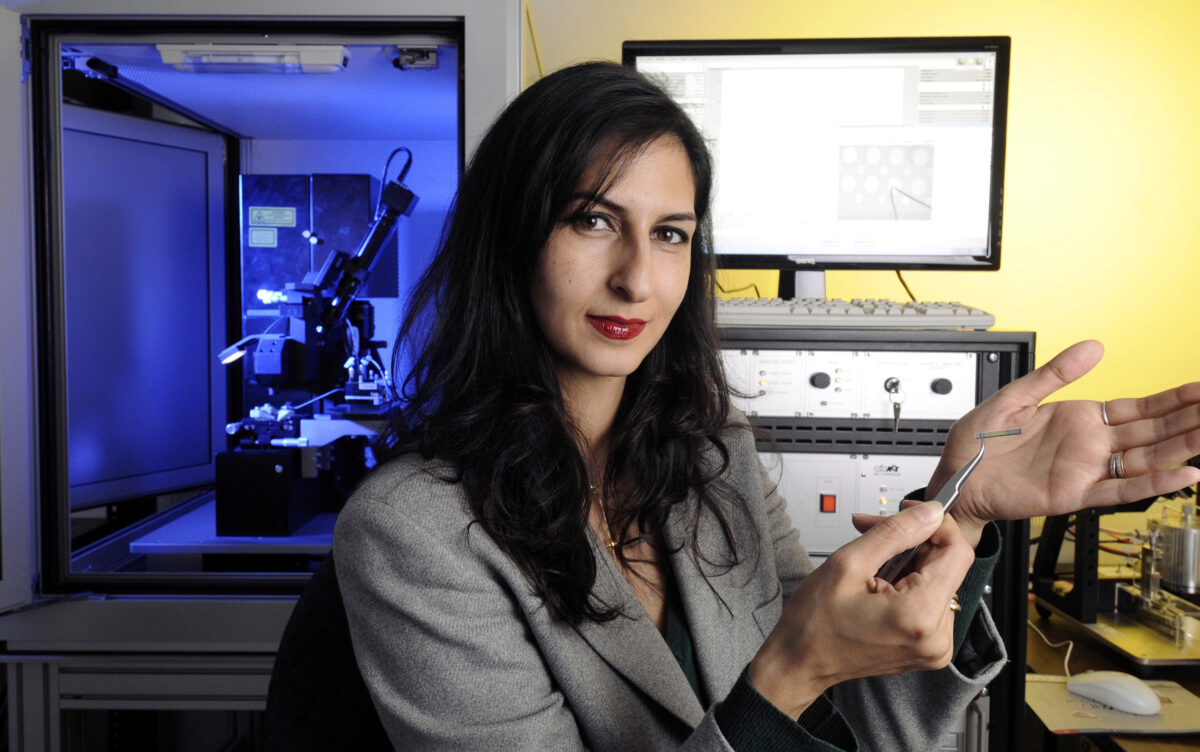If such a designation existed, Nazanin Bassiri-Gharb would be on the fast track to becoming an Oak Ridge National Laboratory (ORNL) “super user.” Her research on nanoscale materials has taken her all across the ORNL campus, from scanning probe and electron microscopes at the Center for Nanophase Materials Sciences to neutron reflectometry at the Spallation Neutron Source and radiation equipment in the Materials Science and Technology Division.
The Georgia Institute of Technology associate professor of mechanical and materials science engineering recently finished a six-month sabbatical at ORNL, which introduced her to more of the lab’s research.
“I keep expanding my footprint,” Bassiri-Gharb said. “You start talking to people, and then you realize there is someone else you should talk to. And these interactions give you the best ideas. You figure out there are ways of probing your field of research that haven’t been considered before.”

“Because they’re electromechanically active, ferroelectrics have the potential to be those artificial ‘muscles’ running things or the material that will allow you to probe at the nanoscale,” Bassiri-Gharb said. “But we don’t completely understand ferroelectrics at the nanoscale. Our lab at Georgia Tech mainly creates new ways to process nanostructures and concentrates on traditional bulk characterization, and we often use characterization facilities at ORNL to probe their local response.”
The Functional Materials Imaging group at ORNL’s Center for Nanophase Materials Sciences, a DOE Office of Science user facility, hosted Bassiri-Gharb’s recent sabbatical, helping her look at new ways of exploring phase transitions in ferroelectric materials. Phase transitions can occur between different crystallographic phases, such as tetragonal and rhombohedral compositions in an all-ferroelectric material, or in a relaxor-ferroelectric (solid solution) system.
“In both cases, phase transitions are key to the enhanced electromechanical and dielectric response of these materials: Being able to probe them at the nanoscale will allow us to understand them, and if we understand better these transitions then we can strive to design new materials that show even larger responses,” she said. “This can be done by looking at signals beyond the typical displacement used in piezoresponse force microscopy, but also by leveraging acoustic and microwave characterization, which is all accomplished at the nanoscale with a scanning probe.”
Working with ORNL’s newly created Institute for Functional Imaging of Materials, Bassiri-Gharb explored novel approaches to study the dynamics of ferroelectric materials at nano-, micro- and meso-scale, attempting to separate the domain wall and intrinsic polarization dynamics. "Essentially, we create artificial periodic perturbations, compared to the natural and complex domain structure, so can effectively explore the excited state of the system," said Bassiri-Gharb, who is one of the first (“and very excited”) users of the IFIM.
Bassiri-Gharb also probed a new method to process ferroelectrics: an ORNL pulse thermal processing technique that can heat a material up to 600,000 degrees Celsius in a second. She used it to create ferroelectric materials directly on a polymer substrate, a combination not feasible with other processing techniques.
“You get these pulses of heat so fast that you can change the phase of the material, crystallize it, or process it even if the substrate is not able to withstand those high temperatures,” she said. “Processing so far away from the typical crystallization temperature can result in much higher or lower concentration of defects. This is one way to directly probe those defects that make ferroelectrics so interesting. The attraction of the defects is they make the properties go really high or plummet down.”
Easy access to ORNL resources has also helped Bassiri-Gharb accelerate the pace of her research. For instance, she initially collaborated with an Italian group on radiation studies before learning about similar capabilities at ORNL -- a few hours from Georgia Tech.
“For me, it’s a great opportunity because if I don’t find the right collaborators internally, then I can find them externally -- and they’re three hours away and they’re the best in the world.”
Written by: Morgan McCorkle of ORNL
